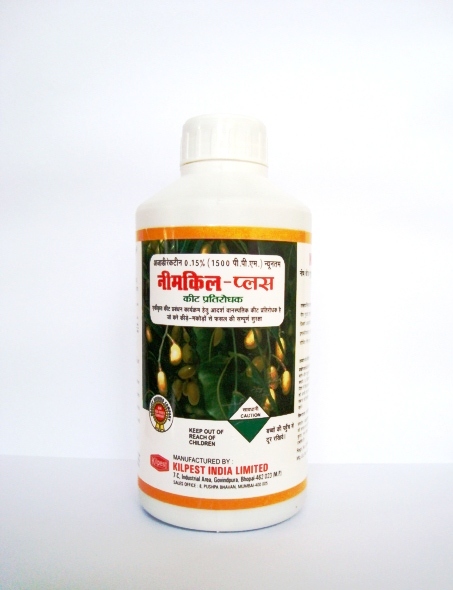Neem Kil
Azadirachtin 0.03%, 0.15%, 1% & 5%
Azadirachtin is a chemical compound belonging to the limonoids. It is a secondary metabolite present in the neem tree seeds. It was found to affect over 200 species of insect, by acting mainly as an antifeedant and growth disruptor, and as such it possesses considerable toxicity toward insects (LD50(S. littoralis): 15 ug/g). It is a wonderful natural insecticide which is biodegradable (it degrades within 100 hours when exposed to light and water) and shows very low or no toxicity to mammals.
We offer 300ppm,1500ppm, 10,000 ppm azadirachtin based neem oil formulation to be used as a botanical insecticide for organic farming; it repels a wide variety of pests including the mealy bug, beet armyworm, aphids, the cabbage worm, thrips, whiteflies, mites, fungas gnats, beetles, moth larvae, mushroom flies, leafminers, caterpillars, locust, nematodes and Japanese beetle. Not known to be harmful for non-target organisms.
Benefits of Azadirachtin
- Broad spectrum of activity
- No Known insecticide resistance mechanisms
- Compatible with many commercial insecticides and fungicides
- New mode of action with possible multiple sites of attack
- Classified as a biological insecticide for registration purposes
- Low use rates.
- Compatible with other biological agents for IPM Programme
- Not persistent in the Environment
- Minimal impact of Non-target organisms
- Formulation flexibility
- No re-entry restrictions
- Supply available from pre-existing infrastructure
- Application flexibility - can be sprayed or drenched
- Non-phytotoxic formulations available
Disease Control
It is a broad-spectrum pesticide, acting as a repellent, growth regulator, and a poison. It controls aphids, leafminers, looper caterpillars, mealybugs, thrips, whiteflies, foliar-feeding beetles, and mites.
| Name of the Crop | Name of the Disease | Disease causing microbe |
|---|---|---|
| Elephant foot yam | Collar rot | Sclerotium rolfsii |
| Chilli, Tomato, Brinjal | Damping off | Pythium, Phytopthara, Fusarium |
| Ginger, Turmeric, Onion | Rhizome rot | Pythium, Phytopthara, Fusariu |
| Chick pea, Banana, Cotton, Tomato, Brinjal | Wilt | Fusarium oxysporum |
Method of Application:
Used in Foilar spray.
Biocontrol mechanisms of Azadirachtin
- Disturbing or inhibiting the development of the eggs, larvae, or pupae.
- Blocking the molting of larvae or nymphs.
- Disturbing mating and sexual communication.
- Repelling larvae and adults.
- Deterring females from laying eggs.
- Deterring feeding
CIB REGISTRATION:
We hold registration for Neem seed kernel based EC containing Azadirachtin 0.15% EC (1500 ppm)min under Central Insecticide Board No. CIR-59, 701/2008-AZADIRACHTIN (EC) (289)-1167 issued by Ministry of Agriculture, Government of India, Directorate of Plant Protection, Quarantine & Storage.
COMPOSITION OF FORMULATION
| Neem seed kernel extract in solvent methanol containing minimum 0.15% Azadirachtin | 60% w/w |
| Emulsifier (Polysorbate 20) | 5%w/w |
| Treated Neem Oil | 35% w/w |
| Total | 100% |
Packing
As a wettable powder 500 gms-1kgs

Other Links
Products
Chemical
Biological
 Go to top
Go to top